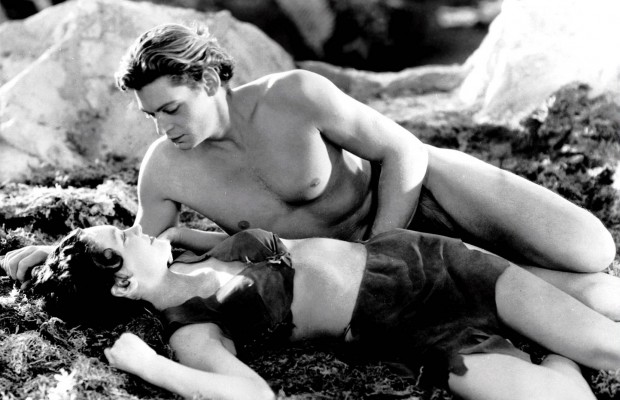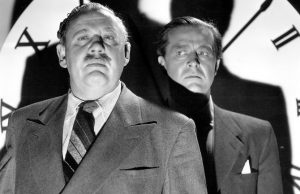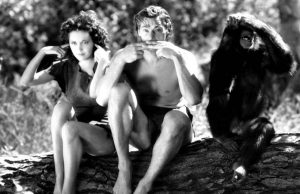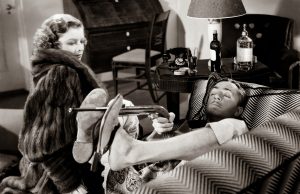Tarzan and His Mate (1934)

Toronto Film Society presented Tarzan and His Mate on Sunday, May 12, 2013 as part of Season 66 May Festival: The Pre-Code Weekend.
I remember watching the Johnny Weissmuller Tarzan films when I was a kid and even though there have been other actors who have played him before, (Elmo Lincoln in 1918s Tarzan of the Apes) and after (Lex Barker-40/50s, Gordon Scott-60s, Mike Henry-60s, Jock Mahoney-60s {who incidentally was Sally Field’s step-father} and Ron Ely-60/70s to name a few—I’ve read there were eleven)  Weissmuller has always been my “true” screen-image. I also read some of the books when I was younger, but after I’d seen the films and the Ron Ely series, I have to admit that I didn’t imagine Johnny Weissmuller then. In fact, the Disney cartoon image was closer to the look, but I realize I was influenced by the artwork of Neal Adams who did the book covers.
Weissmuller has always been my “true” screen-image. I also read some of the books when I was younger, but after I’d seen the films and the Ron Ely series, I have to admit that I didn’t imagine Johnny Weissmuller then. In fact, the Disney cartoon image was closer to the look, but I realize I was influenced by the artwork of Neal Adams who did the book covers.
When I recently watched the first two films of the Weissmuller series, I thoroughly enjoyable them once again. And as an adult, being interested in pre-Code, I loved the risqué relationship Tarzan and Jane have in these cinematic productions. I was certainly surprised to discover footage that I never remembered seeing before—the skinny-dipping scene—where Tarzan removes Jane’s evening gown in one-fell-swoop.
This is one of those early films where black actors got a chance to make a few dollars—in roles considered very “politically incorrect”; lots of obvious foreshadowing of danger—meaning black person dies.
I also love the idea that there really is no story, just a way for the studio to show too lovely-looking people smitten with each other and living happily and “immorally” in a jungle with beautiful, if somewhat dangerous, nature. Watching the animals in these films is also quite thrilling.
One of my favourite scenes is when Jane’s English friends come for a visit while hoping to kill elephants for their ivory. It’s somewhat dementedly hilarious that they would bring her—and I’m sure it  was on the top of her “need-most” list—an evening gown. As well, they absolutely can’t conceive why she would want to stay in the jungles with this uneducated, brute of a man when she could come home to civilization. I’m sure most of the women in the audience enjoyed the fantasy and will continue to do so.
was on the top of her “need-most” list—an evening gown. As well, they absolutely can’t conceive why she would want to stay in the jungles with this uneducated, brute of a man when she could come home to civilization. I’m sure most of the women in the audience enjoyed the fantasy and will continue to do so.
In case you don’t already know, Johnny Weissmuller was an Olympic Swimming Champion. He was one of the world’s best swimmers in the 1920s, winning five Olympic gold medals and one bronze medal. He won 52 US National Championships and set 68 world records.
So please enjoy this great 104 minute romp in the jungle.
Caren Feldman, May 12, 2013
It may be silly, but it continues to be fascinating, this ‘Tarzan’ theme. In ‘Tarzan and His Mate,’ second of the Metro series with Johnny Weissmuller, the monkeys do everything but bake cakes and the very human elephants always seem on the verge of sitting down for a nice, quiet game of chess; yet the picture has a strange sort of power that overcomes the total lack of logic, and (probably most important) it is an extraordinarily beautiful photographic specimen. Picture will doubtless draw business.
Tarzan No. 1 ended with Tarz and the white girl from England at peace in their jungle kingdom. They’re again at peace as No. 2 ends, but in the 92 minutes between the two fade-outs they’re almost in pieces, several times. Trouble starts soon as the domain of Mr. and Mrs. Tarzan (Johnny Weissmuller and Maureen O’Sullivan) is trespassed upon by Neil Hamilton and Paul Cavanaugh, a couple of Miss O’Sullivan’s heels’ from Mayfair. Boys are after the fortune in ivory which lies in a pachyderm graveyard.
There are gory battles between bands of natives to liven up the proceedings when Tarzan isn’t fighting some jungle beast that is just about to devour his mate. Tarz’s stiffest encounters are with a horned rhinoceros and a giant alligator, respectively. His encounter with the rhino is obviously phoney and seemingly impossible, but so well done that it provides a real thrill. The underwater battle  with the ‘gator supplies a big kick also. Tarz’s hand-to-paw grapping with lions are, in comparison, just child’s play, even when one lion is close-upped with Tarzan’s arm in his kisser, and the long teeth showing. Miraculously, when the arm is withdrawn it bears nary a scratch. But such slight discrepancies are easily overlooked, since it’s granted that Tarz is a cinch bet in all matches, despite that he always gives away at least two or three tons in weight.
with the ‘gator supplies a big kick also. Tarz’s hand-to-paw grapping with lions are, in comparison, just child’s play, even when one lion is close-upped with Tarzan’s arm in his kisser, and the long teeth showing. Miraculously, when the arm is withdrawn it bears nary a scratch. But such slight discrepancies are easily overlooked, since it’s granted that Tarz is a cinch bet in all matches, despite that he always gives away at least two or three tons in weight.
But for a white man’s bullet Tarz is just another sucker. He is temporarily felled by a slug tossed at him by Cavanaugh, who at first can’t make up his mind whether he wants the ivory or Mrs. Tarzan, and then decides he wants both. In this animal picture Cavanaugh represents the species skunk.
Apes, of both the genuine and prop variety, play a large part in the picture. One of the real ones, called Chita, does messenger service for Tarz whenever the missus is in danger, such as being sniffed at by the identical pair of lions that a few months before had made a meal of Cavanaugh and Hamilton.
Tarzan and his mate spend most of their time swinging through the branches. Film goes so far as to stage a regulation flying act, with Tarz tossing Mrs. Tarz into an aerial loop, to be caught by the outstretched arms of an ape. The Tarzans also do some fancy swimming, particularly during a tank sequence when Weissmuller and a lady swimmer doubling for Miss O’Sullivan, perform some artistic submarine formations. The lady is brassiere-less but photographed from the side only.
Weissmuller duplicates his first Tarzan performance, which means the girls probably will go strong for him again. Miss O’Sullivan, never wearing much in the way of clothes, isn’t bad to look at from the masculine viewpoint.
The Culver City jungle and studio ‘exteriors’ were so constructed as to look like the real thing. In every technical department picture is first grade.
VARIETY, Bige., April 24, 1934
Perhaps only three of the many adventure films of the 30’s really lived up to both their potential and their advertising promises: King Kong, Gunga Din and most certainly Tarzan and His Mate. It’s far and away the best, most elaborate and most actionful of all the Tarzans, its single flaw being that of all the MGM Tarzans, the radical changing of the Tarzan character himself from the far more  civilized and educated individual created by Burroughs. (Only Bruce Bennett was allowed to follow that concept in the independently-made New Adventures of Tarzan). That shortcoming apart, Tarzan and His Mate is grand stuff. It ran into the usual MGM production hassles: filming was stopped at one point, the director removed (Cedric Gibbons, an art director and a brilliant one, always wanted to direct—but had absolutely no understanding of that craft) and an original player, Rod la Rocque, replaced by Paul Cavangh and much footage re-shot. But none of these contretemps show up on screen. Too much exposure of Maureen O’Sullivan in a nude swimming scene sadly resulted in much of that sequence being deleted, and the extremely sparse costuming of both Jane and Tarzan raised some production code eyebrows, and their wardrobe was somewhat extended in later films in the series. Today the film is too rarely shown—on tv, at university campuses and elsewhere—because of the trouble it invariably causes with its cavalier treatment of the natives as being somewhat less than human beings. Natives were always used in the Tarzan as useful “demonstrations” of all the perils involved: it was always some hapless native porter who would fall off a ledge just before Jane got to that danger point, be mauled by a lion, or several of them would systematically be killed off in various tribal tortures (often quite ingenious!) in order to lengthen the suspense leading to Tarzan’s fortuitous rescue of the white safari. (Though usually he was just too late to save the white villain!) Here admittedly, the natives get even shorter shrift than usual, with Neil Hamilton blithely and somewhat irritatedly remarking how many of his native boys were wiped out on safari—almost twice the number he had originally estimated. However, it is unfair to condemn the movies for such attitudes; the criticism should instead by aimed at the generally held attitudes of the time, which the movies merely reflected and unwittingly recorded.
civilized and educated individual created by Burroughs. (Only Bruce Bennett was allowed to follow that concept in the independently-made New Adventures of Tarzan). That shortcoming apart, Tarzan and His Mate is grand stuff. It ran into the usual MGM production hassles: filming was stopped at one point, the director removed (Cedric Gibbons, an art director and a brilliant one, always wanted to direct—but had absolutely no understanding of that craft) and an original player, Rod la Rocque, replaced by Paul Cavangh and much footage re-shot. But none of these contretemps show up on screen. Too much exposure of Maureen O’Sullivan in a nude swimming scene sadly resulted in much of that sequence being deleted, and the extremely sparse costuming of both Jane and Tarzan raised some production code eyebrows, and their wardrobe was somewhat extended in later films in the series. Today the film is too rarely shown—on tv, at university campuses and elsewhere—because of the trouble it invariably causes with its cavalier treatment of the natives as being somewhat less than human beings. Natives were always used in the Tarzan as useful “demonstrations” of all the perils involved: it was always some hapless native porter who would fall off a ledge just before Jane got to that danger point, be mauled by a lion, or several of them would systematically be killed off in various tribal tortures (often quite ingenious!) in order to lengthen the suspense leading to Tarzan’s fortuitous rescue of the white safari. (Though usually he was just too late to save the white villain!) Here admittedly, the natives get even shorter shrift than usual, with Neil Hamilton blithely and somewhat irritatedly remarking how many of his native boys were wiped out on safari—almost twice the number he had originally estimated. However, it is unfair to condemn the movies for such attitudes; the criticism should instead by aimed at the generally held attitudes of the time, which the movies merely reflected and unwittingly recorded.
WILLIAM K. EVERSON, April 23, 1972
TARZAN AND HIS MATE, Metro production and release. Directed by Cedric Gibbons (Jack Conway-co-director, uncredited and James C. McKay-uncredited), Story by J. Kevin McGuinness, based on Edgar Rice Burroughs’ characters; adapted by Howard Emmett Rogers and Leon Gordon; camera, Charles Clarke and Clyde De Vinna.
Having apparently dwelt in the jungle since they met in “Tarzan, the Ape Man,” Johnny Weissmuller, the swimming ace, and the comely Irish colleen, Maureen O’Sullivan, are now to be seen at the Capitol in a sequel to their first adventure. The current offering, which is hailed as “Tarzan and His Mate,” is, if anything, even more fantastic than its predecessor. One gathers that the first year of  Tarzan and Jane Parker (Miss O’Sullivan) in the African wilds has been a happy one, that they have made many friends among apes and elephants and that they have dozens of arboreal abodes.
Tarzan and Jane Parker (Miss O’Sullivan) in the African wilds has been a happy one, that they have made many friends among apes and elephants and that they have dozens of arboreal abodes.
Harry Holt and Martin Arlington are companions on an expedition. Holt hopes to win back his sweetheart, Jane, but Arlington’s only wish is to bring back plenty of ivory. It seems to be no more difficult to find Tarzan and Jane than it is to locate Times Square in Manhattan. Jane’s wardrobe is limited and the very thoughtful Holt has brought with him trunks filled with many gowns and frocks, some of which are not precisely suited to leaping from tree to tree as Tarzan and his mate do. Perfume and various other gifts to appeal to the feminine taste also are brought by the lovelorn Holt.
Tarzan does not think much of the perfume and even less of a silk gown. He is a man of the forest, an emperor, so to speak, of the jungle, who likes to get his breakfast by diving into a pool and bringing forth a fish. Coffee has a peculiarly distasteful flavour to him. He does, however, cherish his hunting knife, for with it he has laid low many jungle outlaws, such as lions, tigers, leopards, rhinoceroses, hippopotamuses, and so forth.
It does not even take Tarzan’s breath away to have a set-to in the water with a crocodile, and Jane expects him to emerge from the fray victorious, as he does at all times. Here he rides astride a rhinoceros and has encounters with a variety of animals. It is all in a day’s work! He even expects Jane to be as agile as he is, seeing to it that she does her daily dozen, in the shape of springing from  branch to branch and taking headers into lakes. Tarzan is no easy person to please. He speaks only an occasional word, and even then he gets mixed up, which is apt to make one conclude that there must be days that pall upon Jane. Yet she prefers the jungle to Mayfair.
branch to branch and taking headers into lakes. Tarzan is no easy person to please. He speaks only an occasional word, and even then he gets mixed up, which is apt to make one conclude that there must be days that pall upon Jane. Yet she prefers the jungle to Mayfair.
They yowl to each other and cover distances far quicker via the trees than they could on the ground. In case there should not be enough excitement furnished by jungle fauna and the villainous Arlington, who, be it known, would do anything for a couple of hundred ivory tusks, there is a host of savages, evidently of two different tribes. These natives are quite expert with their spears and arrows.
Aside from the wild tale, this film is a marvel from a photographic standpoint. Tarzan has his hand-to-hand encounters with leopards, hippopotamuses and other beasts, and Jane has anything but a merry time with several lions. Some of them are evidently riddled with bullets, but just as one may think that the beasts’ teeth have been extracted and that their mouths are wired one perceives Tarzan’s arm in a lion’s jaw equipped with splendid white teeth. In another instance one perceives an elephant limping along and finally lying down to die in a spot known as “the elephants’ burial ground”. This provoked from a young lass: “Oh, the poor lamb!” Just got her animals mixed, but her sympathy was sincere.
Needless to say that Miss O’Sullivan and Mr. Weissmuller acquit themselves in the same favourable fashion they did in their former hectic experiences.
NEW YORK TIMES, by Mordaunt Hall, April 21, 1934
Notes compiled by Caren Feldman










Leave a Reply